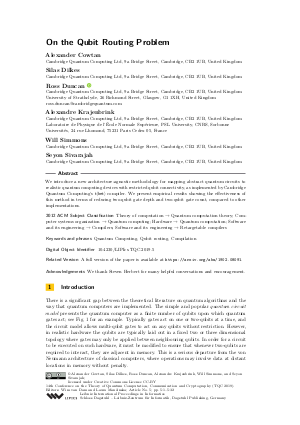@InProceedings{cowtan_et_al:LIPIcs.TQC.2019.5,
author = {Cowtan, Alexander and Dilkes, Silas and Duncan, Ross and Krajenbrink, Alexandre and Simmons, Will and Sivarajah, Seyon},
title = {{On the Qubit Routing Problem}},
booktitle = {14th Conference on the Theory of Quantum Computation, Communication and Cryptography (TQC 2019)},
pages = {5:1--5:32},
series = {Leibniz International Proceedings in Informatics (LIPIcs)},
ISBN = {978-3-95977-112-2},
ISSN = {1868-8969},
year = {2019},
volume = {135},
editor = {van Dam, Wim and Man\v{c}inska, Laura},
publisher = {Schloss Dagstuhl -- Leibniz-Zentrum f{\"u}r Informatik},
address = {Dagstuhl, Germany},
URL = {https://drops.dagstuhl.de/entities/document/10.4230/LIPIcs.TQC.2019.5},
URN = {urn:nbn:de:0030-drops-103972},
doi = {10.4230/LIPIcs.TQC.2019.5},
annote = {Keywords: Quantum Computing, Qubit routing, Compilation}
}

 Creative Commons Attribution 3.0 Unported license
Creative Commons Attribution 3.0 Unported license




